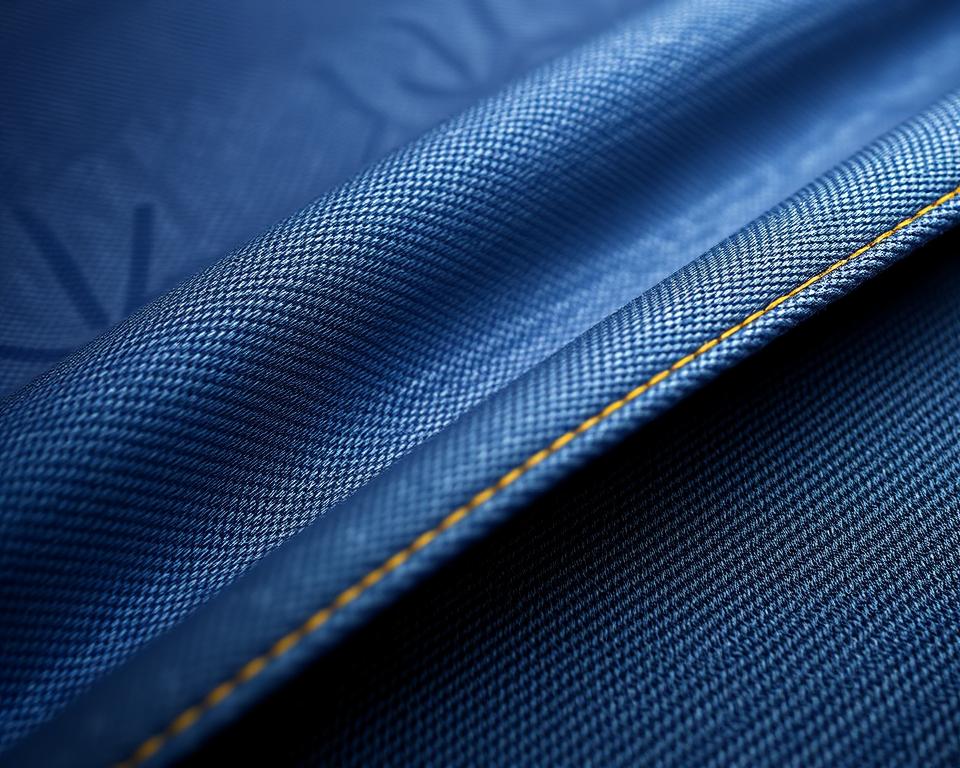Your Manual to Superior denim Edge-to-Edge Material
Ever pondered why certain trousers feel like they’re made to last a lifetime? The secret lies in the elements and skill. For example, the rising trend of superior selvedge. This goes beyond common material—it’s a testament to excellence and tradition.
Nowadays, more people are turning to these timeless fabrics for their robustness and traditional selvedge denim fabric charm. Be it that you are a DIY sewist or a denim enthusiast, there’s something special about using superior cotton and yarn. It’s not just about creating jeans; it centers on fashioning a narrative.
Within Core Fabrics, we’ve assembled a range of 14.25oz eco-friendly cotton and elastic options. These fabrics are tailor-made for everything from raw jeans to designer jacket blueprints. Eager to discover the universe of exceptional fabrics? Let’s dive in.
Defining Denim Selvedge Fabric?
What makes certain trousers set themselves apart with their signature, naturally edged borders? The key resides in the selvedge denim, a high-quality textile known for its robustness and retro charm. Unlike regular textiles, this type of fabric is fashioned with time-honored methods that have stood the test of time.
The Definition of Selvedge Denim
Selvedge denim is manufactured via old-style shuttle looms, which yield slender widths of about 30-35 inches. The looms interlace the textile in a way that creates self-finished edges, often highlighted by a characteristic red line. Such a process guarantees the textile is tightly woven and extremely robust.
Contemporary looms, on the other hand, yield expansive textile but do not offer the comparable degree of craftsmanship. Subtle irregularities in selvedge, like misaligned seams or uneven textures, are accepted as elements of its beauty. This philosophy, often referred to as “wabi-sabi”, celebrates the aesthetic of inherent flaws.
How Selvedge Denim Is Made
The manufacturing of selvedge denim entails a exacting process. These looms weave the horizontal threads back and forth, forming a compact and robust fabric. Unlike modern methods with contemporary machines, which focus on quick production and efficiency over quality.
Brands like Karson Denim uphold time-honored Japanese weaving techniques from the nineteen-nineties. They purposefully add flaws to retain the genuineness of the textile. Every item is assessed on a four-point system, guaranteeing it fulfills the highest standards of excellence.
| Characteristic | Selvedge Denim | Contemporary Denim |
|---|---|---|
| Width | 30-35 inches | 60+ inches |
| Fabrication Method | Traditional Shuttle | Modern Loom |
| Texture | Irregular, Flawed | Consistent |
| Strength | Superior | Moderate |
“The charm of selvedge lies in its imperfections—each irregularity speaks of skill and legacy.”
The Background of Selvedge Denim
Starting from modest origins to international fame, the tale of these textiles is rich and inspiring. What started as durable workwear in the 17th-century France transformed into a mark of everlasting fashion and excellence.
Historical Roots
The foundation of this textile dates back to Nîmes, France, where it was referred to as “serge de Nîmes.” First intended for laborers, it was crafted out of robust cotton and thread. Its strength made it a favorite among the workforce during the era of the Gold Rush.
In the 20th century, it had transformed into a staple for jeans. The closure of the Cone Mills White Oak facility became a pivotal moment. This shift opened the door for Japanese artisans to restore classic fabric-making practices.

Evolution in Modern Denim Production
Post-WWII, Japan adopted retro American culture. Craftsmen revitalized classic looms to manufacture authentic reproductions. This dedication to quality guaranteed the perseverance of selvedge as a specialty product.
Today, breakthroughs from Italy and Turkey have introduced eco-friendly blends and elastic options. These modernizations have enhanced the appeal of this timeless textile. Within Core Fabrics, we gather worldwide, from Montréal to Asia, to offer you the finest standards.
“The legacy of selvedge is a testament to the enduring value of craftsmanship and legacy.”
The Benefits of Selvedge Denim?
Why does selvedge denim shine in the world of premium materials? Its special characteristics and unmatched durability render it popular among lovers and designers alike. Be it that you are making pants or a sharp jacket, this material provides a mix of heritage and updated style.
Characteristic Features of Selvedge
Selvedge denim is renowned for its dense construction, which improves ripping resistance and color fading characteristics. In contrast to common fabrics, rainbow selvedge denim is crafted using traditional shuttle looms, resulting in a more compact and exceptionally sturdy material. Such a process guarantees that each piece has a unique texture and character.
Key features include:
- Hairy, rigid raw denim contrasts with pre-washed comfort stretches.
- Sanforization stabilizes the fabric for consistent measurements, while natural variants entail a unique shrinkage journey.
- Weight options range from 9.5oz Eco Finish to 14.25oz Organic, catering to different needs.
Sturdiness and Lifespan
One of the standout features of selvedge denim is its enduring nature. The tighter weave not only increases durability but also allows for characteristic wear patterns over time. This renders it a valuable investment for those in pursuit of timeless pieces.
Key points to consider:
- Fabrics weighing between 12oz and 14oz are perfect for form-fitting jackets and jeans that mellow with time.
- The 14.25oz True Indigo option is highly favored for enduring jeans.
- Sustainable variants such as recycled cotton combined with indigo blends enhance eco-friendliness.
Within our range at Core Fabrics, diverse choices cater to distinct demands. Spanning from raw finishes to sanforized treatments, each selection is designed for superior quality and value.
Selvedge vs. Wide Denim: A Comparison
When it comes to crafting durable and stylish garments, the decision of textile matters significantly. Among the prevalent selections are selvedge and wide denim, both offering different features. Knowing how they differ assists in selecting the best option for your creation.
Contrasting Weave Techniques
Selvedge denim is crafted with traditional shuttle looms, yielding slim widths of 30-35 inches. This striped selvedge denim fabric method creates secure finishes, often marked by a signature red line. Conversely, wide denim employs advanced projectile looms, resulting in spans of 60+ inches.
Shuttle looms are slower, producing about 3 meters per minute, while modern projectile looms reach speeds of 30 meters per minute. The variance in production speed affects both the expense and the surface quality of the outcome.
Pros and Cons of Each Type
Selvedge denim is celebrated for its superior quality and strength. Its limited breadth makes it ideal for applications where defined edges and detail work are sought. However, it can be pricier, typically around $23 per meter.
Wide denim is economical, ranging at $8 per half-meter. Its wider width minimizes excess, ideal for extensive endeavors like furniture covering. However, it does not feature the signature finished border of selvedge.
| Attribute | Selvedge Denim | Wide Denim |
|---|---|---|
| Measurement | 30-35 inches | 60+ inches |
| Technique | Traditional Shuttle | Contemporary Projectile Loom |
| Rate | 3 meters per minute | 30 meters per minute |
| Price | $23/meter | $8 per half-meter |
For defined borders as seen in Grainline Thayer jackets, selvedge is favored. In contrast, wide denim provides cost-effectiveness and speedy production. Evaluate your project specifications to choose wisely.
How to Use Selvedge Denim
Working with premium materials can elevate your sewing projects to the next level. Be it making pants, jackets, or dresses, understanding the basics of yardage, sewing techniques, and care ensures a professional finish. Let’s delve into ways to best utilize this timeless fabric.
Yardage Needed for Jeans and Jackets
It is essential to compute the correct fabric amount when designing your creation. Men’s jeans typically require roughly 3-3.3 yards, factoring in flaws and potential shrinkage. Trucker-style jackets generally demand about 3.3 yards, while skirts require only 2 yards.
Creative pattern placement can help manage imperfections in the material. Embrace the natural defects by weaving them into your creative design.
| Project | Fabric Needed |
|---|---|
| Jeans for Men | 3-3.3 yards |
| Trucker Jacket | 3.3 yards |
| Skirt | 2 yards |
Advice for Sewing and Longevity
Using the right tools and techniques ensures a polished result. Choose #70 to 110 needles and presser foot attachments designed for heavy materials. Gütermann rPET thread works well for contrasting stitches.
Additional advice includes:
- Employ a tailor’s clapper to achieve crisp creases without gloss.
- Core Fabrics provides denim kits with topstitch thread, rivets, and 9mm buttons for that expert touch.
- Structured edges, essential for jackets, are best achieved with selvedge.
Maintaining your pieces properly increases their longevity. Use minimal washing and opt for air drying to preserve fabric quality. Adhering to these practices will sustain your creations for years.
Wrapping It Up
Using superior fabrics goes beyond mere durability—it’s about instilling personality. Selvedge denim embodies this philosophy, merging handcrafted appeal with robust strength. Be it crafting jeans or tailoring a refined jacket, each stitch narrates a tale.
With Core Fabrics, unleashing your creative potential is effortless. Our swatch service lets you touch and test the fabric before deciding. Furthermore, take advantage of free shipping for orders above $150 USD in North America.
Eco-friendly mixtures and classic washes are paving the way for the next generation of cotton fabrics. These trends offer new ways to add sustainability and style to your wardrobe.
Ready to dive into the world of premium materials? Shop now and discover the value of crafting with purpose. Your subsequent creation may well become an enduring classic.

